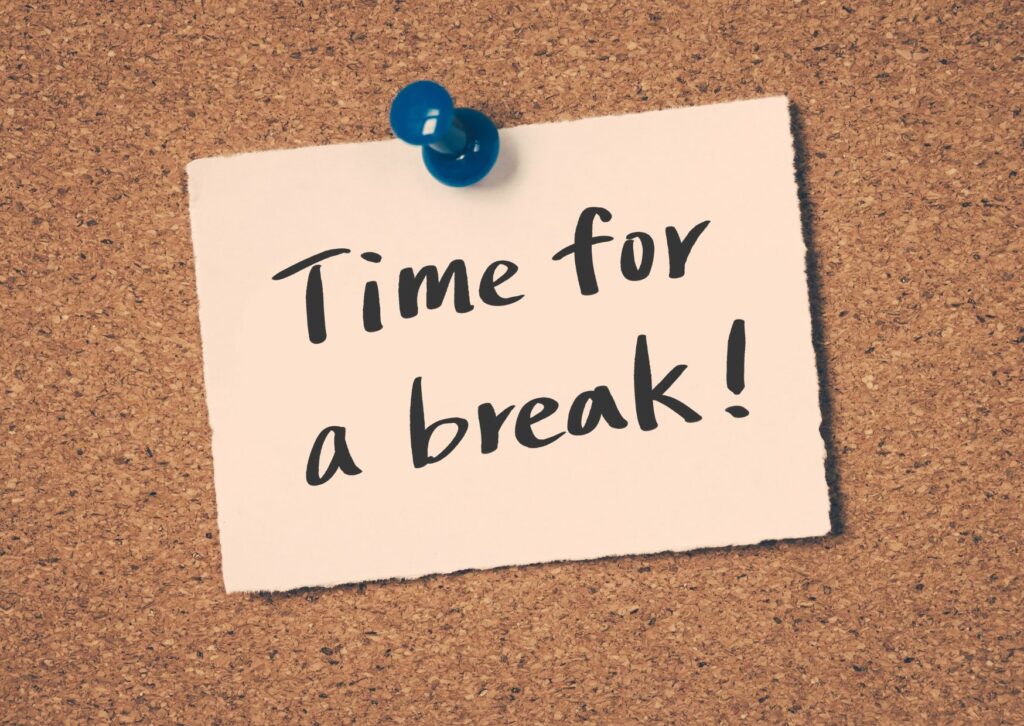Microbreaks at Work and Their Impact on Employee Wellbeing
Microbreaks at work are something that not many companies have caught onto yet.
However, those that have, understand the powerful impact they can have on their employees.
As the pace of our professional lives accelerates, these brief pauses are more crucial than ever for maintaining employee wellbeing.
As a wellbeing speaker and wellbeing workshop facilitator, I’ve observed firsthand the transformative effects of these short breaks.
They’re not just about taking a breather but about recharging, refocusing, and revitalising our minds and bodies.
In this blog, we’ll delve into the intricacies of microbreaks, understand the research backing their benefits, and offer guidance on implementing them effectively in your workplace.
Contents
The Research Behind Microbreaks
The Impact of Microbreaks on Employee Wellbeing
How to Implement Microbreaks in the Workplace

What are Microbreaks?
Microbreaks are short, frequent pauses taken throughout the workday.
Unlike the traditional 15-minute coffee break or hour-long lunch break, microbreaks typically last anywhere from 30 seconds to 5 minutes.
Their shortness and frequency is what makes them so unique and effective.
Instead of waiting for a designated break time, employees can take microbreaks whenever they feel the need to reset, be it mentally, physically, or emotionally.
Think of microbreaks as tiny investments in your wellbeing. They can be as simple as:
- Stretching your arms and legs.
- Taking a few deep breaths to centre yourself.
- Looking away from your computer screen to rest your eyes.
- Walking around your workspace to improve circulation.
- Engaging in a brief, light-hearted conversation with a colleague.
- Practicing a few minutes of mindfulness or meditation.
- Sipping water or grabbing a healthy snack.
The primary goal of a microbreak is to provide a quick respite from continuous work, helping to reduce fatigue, alleviate stress, and re-energise the brain and body.
They’re not about escaping work, but rather enhancing the quality of work by ensuring that employees remain refreshed and alert throughout the day.
In the long run, these small moments of pause can lead to increased productivity, improved focus, and a more positive work experience.

The Research Behind Microbreaks
The concept of microbreaks isn’t just a trendy workplace fad, it’s grounded in scientific research.
Numerous studies have delved into the efficacy of these short pauses, demonstrating their potential to boost both physical and psychological wellbeing.
Cognitive Refreshment
A study published in the journal Cognition found that prolonged attention to a single task can impair performance.
However, brief diversions, like microbreaks, can significantly improve focus and the overall quality of work.
Reduced Physical Strain
For those with desk jobs, sitting for extended periods can lead to musculoskeletal problems.
According to the HSE, in the UK, 7.3 million working days are lost due to musculoskeletal disorders.
Research in the National Library of Medicine indicates that 5-minute stretching breaks can decrease the discomfort associated with prolonged sitting.

Mental Wellbeing
A study from the University of Illinois highlighted the relationship between short breaks and reduced stress levels.
Participants who took microbreaks reported feeling less fatigued and more mentally agile3.
Enhanced Productivity
Contrary to the belief that continuous work maximises output, research suggests that brief interruptions can actually boost overall productivity.
The study suggests that these breaks allow the brain to ‘reset,’ leading to improved task performance.
Eye Health
Staring at screens for long durations can lead to digital eye strain.
The American Optometric Association recommends the 20-20-20 rule: every 20 minutes, take a 20-second break and look at something 20 feet away to reduce eye strain.
As you can see from above, the science is clear.
Microbreaks offer a range of benefits that can profoundly impact an employee’s work experience.
By understanding and applying this research, businesses can foster a healthier, more productive environment.

The Impact of Microbreaks on Employee Wellbeing
Employee wellbeing is multifaceted, encompassing physical, emotional, and cognitive health.
As the modern work landscape continues to evolve, the importance of addressing each aspect of wellbeing becomes increasingly evident.
Here’s how microbreaks play a pivotal role in enhancing overall employee wellbeing:
Physical Health Improvements
Continuous sitting and screen time can lead to various physical ailments, from back pain to eye strain.
Microbreaks promote movement, reducing the risk of musculoskeletal issues and improving physical health.
Stretching or walking around for a few minutes helps improve circulation, mitigates the risk of chronic conditions associated with prolonged sitting, and aids in posture correction.
Boost in Mental Health
The repetitive nature of many jobs can be mentally exhausting.
Microbreaks offer a psychological respite.
By stepping away, even momentarily, employees can alleviate feelings of stress and anxiety.
Over time, this contributes to a decrease in burnout rates and promotes a healthier mental state.

Enhanced Cognitive Function
Our brains aren’t wired to maintain focus on a single task for extended periods.
Microbreaks can act as a cognitive reset.
Studies have shown that regular short breaks help maintain consistent levels of concentration, improve memory retention, and boost overall cognitive function.
Emotional Resilience
Quick breaks can also provide emotional relief.
Whether it’s a brief chat with a colleague, a moment of mindfulness, or simply gazing out of the window, these pauses can elevate mood, foster a sense of belonging, and build emotional resilience.
Increase in Job Satisfaction
Employees who regularly take microbreaks often report higher job satisfaction.
Feeling refreshed and valued contributes to a positive work environment, which in turn leads to increased motivation and a greater sense of loyalty to the company.
Strengthened Social Connections
Interpersonal relationships play a crucial role in workplace wellbeing.
Microbreaks offer opportunities for casual interactions with colleagues, fostering a sense of community and improving team dynamics.
In essence, the introduction and encouragement of microbreaks in the workplace can lead to a holistic improvement in employee wellbeing.
By addressing physical discomforts and reducing mental fatigue, microbreaks can transform the very fabric of the work environment.
This makes it more conducive to growth, innovation, and overall employee happiness.

How to Implement Microbreaks in the Workplace
Implementing microbreaks effectively requires a blend of organisational strategies and individual commitment.
As workplaces seek to prioritise employee wellbeing, the introduction of microbreaks can serve as a powerful tool.
Here are actionable steps organisations can take to seamlessly integrate microbreaks into the daily workflow:
Educate and Advocate
Begin by educating employees about the benefits of microbreaks.
Hosting workshops or sharing informative material can raise awareness and encourage employees to incorporate these breaks into their routines.

Introduce Microbreak Software
There are various tools and software designed to remind users to take regular breaks.
These applications can be customised to prompt employees to pause at intervals that suit their work pattern.
Designate Microbreak Zones
Create designated areas in the office where employees can step away from their desks.
These zones can be equipped with comfortable seating, plants, or relaxation tools like stress balls to enhance the break experience.
Encourage Physical Movement
Promote activities like stretching exercises or short walks.
Consider sharing a set of quick exercises that can be done right beside the desk or in the break zone.

Foster a Supportive Culture
Managers and team leaders should set the tone by taking microbreaks themselves and encouraging team members to do the same.
This helps in normalising the practice and makes employees feel comfortable taking breaks without feeling judged.
Flexible Break Schedules
Allow employees to choose when to take their microbreaks.
While some might prefer regular intervals, others may want to take breaks at specific times, depending on their workload and energy levels.
Promote Mindfulness and Meditation
Even a couple of minutes of mindfulness or deep breathing can have rejuvenating effects.
Consider introducing short guided meditation sessions or breathing exercises that employees can engage in during their breaks.

Feedback and Iteration
After introducing microbreaks, seek feedback from employees on their effectiveness.
Understand their preferences and adjust the strategies accordingly for better adoption.
Celebrate the Microbreaks
Share success stories or testimonials from employees who have benefited from microbreaks.
This not only motivates others but also reinforces the positive impact of these breaks.
Set Boundaries
While microbreaks are beneficial, it’s essential to ensure they don’t disrupt the overall workflow.
Establish guidelines on the duration and frequency of breaks to maintain a balance between rest and productivity.
Incorporating microbreaks into the workplace is not just about introducing short pauses but fostering a culture of care and understanding.
By recognising the significance of employee wellbeing and taking proactive steps to enhance it, organisations can create a more engaged, motivated, and productive workforce.

Microbreaks, though brief, are powerful catalysts for enhancing employee wellbeing and productivity.
By integrating these short pauses into our work routines, we’re not just taking a momentary respite but investing in a brighter, more efficient, and harmonious future for both employees and organisations.
As we move forward, let’s embrace the art of pausing, recognising its potential to reshape our workdays and redefine success in the workplace.
Remember, it’s often in the quiet moments of pause that the loudest transformations occur.
Author
Tyler Lowe – Health & Wellbeing Speaker
BSc Sport & Exercise Rehabilitation


